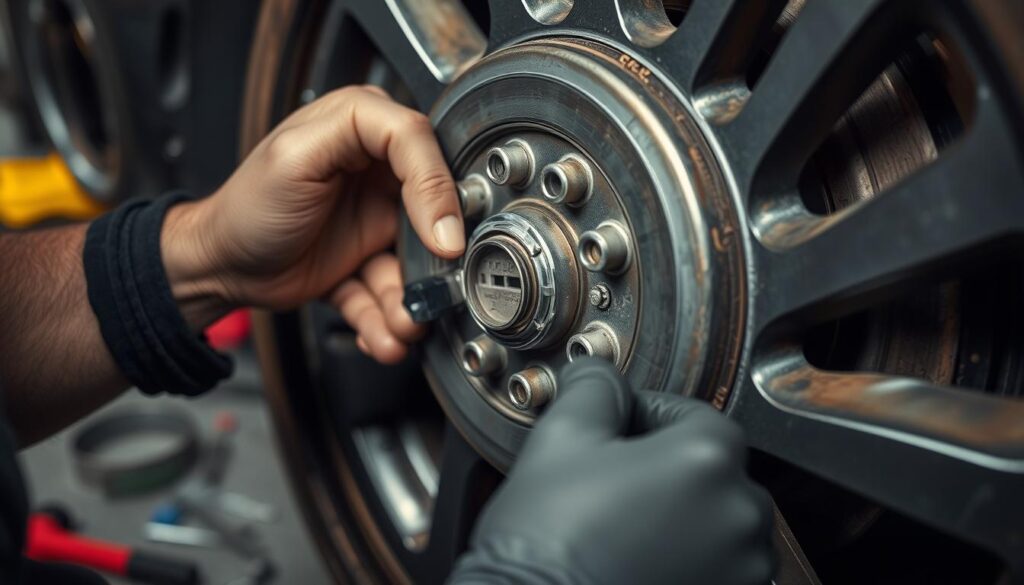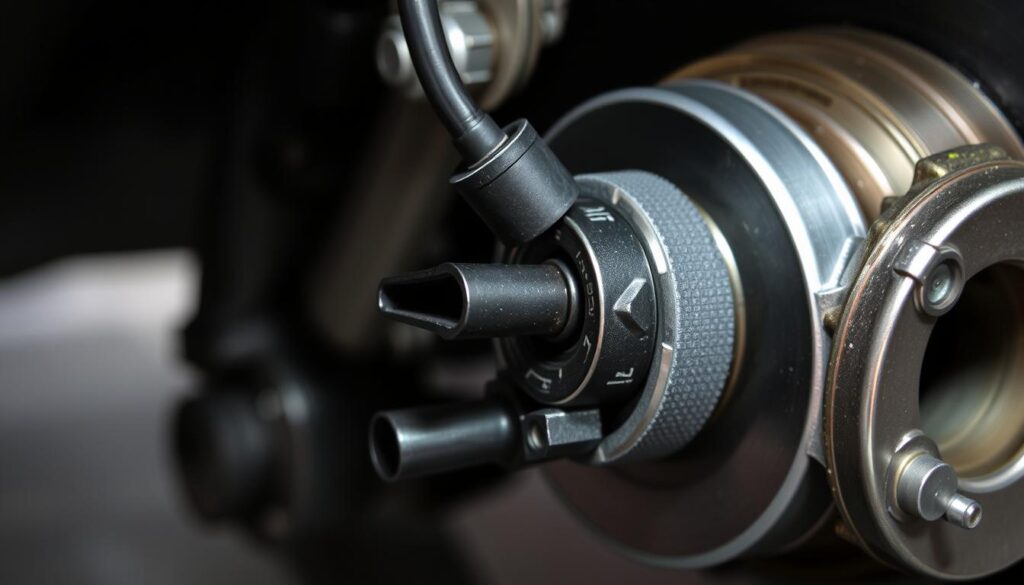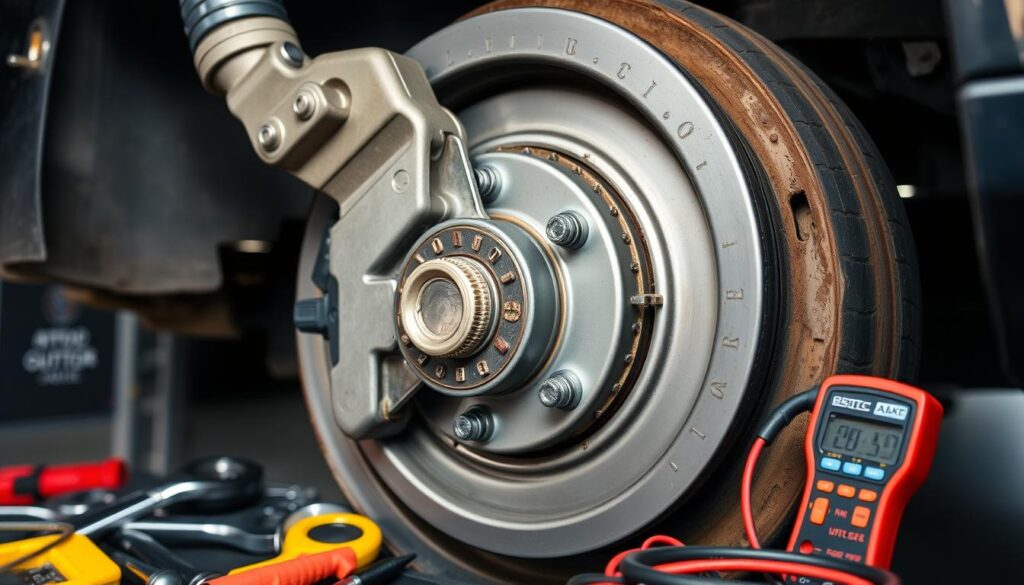I love cars and know how important the Anti-lock Braking System (ABS) is. It keeps us safe on the road. The ABS sensors watch each wheel’s speed to stop lockups during hard braking. But, what if one sensor fails? Let’s look at how to spot and fix a bad ABS sensor.
Key Takeaways
- ABS sensors are responsible for monitoring wheel speed and providing feedback to the ABS system.
- Symptoms of a bad ABS sensor include warning lights, braking issues, and stability problems.
- Diagnostic tools like OBD-II scanners and multimeters can help identify the faulty sensor.
- Regular maintenance and prompt attention to ABS sensor issues can ensure your vehicle’s safety and performance.
- Professional assistance may be required for complex ABS system diagnosis and repair.
Understanding ABS Sensors and Their Function
The Anti-lock Braking System (ABS) is key in keeping cars safe. ABS sensors are at the heart of this system. They watch the speed of each wheel and send this info to the ABS computer.
This computer then changes the brake pressure. It does this to stop the wheels from locking up. This is important during sudden stops or on slippery roads.
What is an ABS Sensor?
An ABS sensor checks the speed of a car’s wheels. There are two kinds: passive (magnetic) and active (Hall-effect) sensors. Passive sensors make their own signal. Active sensors get a signal from the ABS computer.
How ABS Sensors Work
ABS sensors track the speed of each wheel. They send this info to the ABS computer. The computer then checks the wheel speeds.
It adjusts the brake pressure on each wheel. This keeps the wheels from locking up. It helps the car stay in control during braking.
Importance of ABS Sensors in Vehicle Safety
ABS sensors are key for the ABS system to work right. This system makes driving safer and more stable. It stops wheels from locking up.
This helps the driver keep control, even in emergency stops. Without working ABS sensors, the system can’t check wheel speed. This makes the car less safe and harder to handle.
“The ABS system is an essential safety feature that can make the difference between a controlled stop and a loss of control.”
Working ABS sensors are important for the ABS, traction control, and electronic stability control systems. These systems all help keep the car safe and easy to handle. Knowing how ABS sensors work is key to keeping a car safe.
Signs of a Bad ABS Sensor
The first sign of a bad ABS sensor is the ABS warning light on your dashboard. This light means there’s a problem with your vehicle’s anti-lock braking system (ABS). When it’s on, the system can’t work right.
You might also notice your brakes don’t work well. The brake pedal might feel spongy or pulse. The ABS might not work right when you brake, making it hard to stop.
- ABS warning light illuminated on the dashboard
- Unresponsive or spongy brake pedal
- Inconsistent ABS function during braking
The ABS system uses wheel speed sensors to check each wheel’s speed. If a sensor is bad, the ABS might not work right. This can also mess with your vehicle’s stability and traction control, making it less safe to drive.
“A faulty ABS sensor can cause significant issues with your vehicle’s braking system, potentially leading to dangerous situations on the road. It’s important to address any signs of a problem promptly.”
It’s key to spot these warning signs early and fix them fast. This keeps your vehicle’s brakes safe and working well. By watching for ABS sensor problems, you can drive more smoothly and safely.

Diagnosing ABS Sensor Issues
Fixing ABS sensor problems is key to keeping your car’s brakes working right. Use an OBD-II scanner and do a detailed look to find the problem.
Using an OBD-II Scanner
An OBD-II scanner is a great tool for finding ABS sensor issues. It connects to your car’s computer. This lets you see any ABS sensor codes stored in it. These diagnostic trouble codes (DTCs) tell you which part might not be working right.
Visual Inspection of ABS Components
Looking at the ABS diagnostic tools and parts can also help. Check the ABS sensor for damage like cracks or corrosion. Also, make sure the wiring and connectors are okay.
Understanding Diagnostic Trouble Codes (DTCs)
After getting the ABS sensor codes, it’s important to know what they mean. These codes give you a clear picture of the ABS system’s problem. This helps you fix the issue quickly.

“Regular car scanner checks can prevent minor ABS sensor issues from escalating into major safety threats.”
Using an OBD-II scanner, doing a visual check, and knowing about DTCs helps you find and fix ABS sensor problems. This keeps your car’s brakes safe and reliable.
Common Causes of ABS Sensor Failure
As a driver, knowing why ABS sensors fail is key. They help your car stop safely. Let’s look at what usually goes wrong with them.
Damage from Road Debris
One big reason ABS sensors fail is road debris. Potholes and rocks can hit them. This often happens to the front wheels, where they’re more at risk.
Electrical Issues in Wiring
Wiring problems can also cause ABS sensor failure. Short circuits or corrosion can mess up the signal. This makes the ABS system not work right.
Wear and Tear Over Time
ABS sensors wear out with time and miles. This can make them read speeds wrong. Replacing them when needed can stop this.
| Failure Cause | Potential Consequences | Preventive Measures |
|---|---|---|
| Road Debris Damage | Sensor malfunction, ABS system failure | Regular wheel well and undercarriage inspection, avoidance of potholes and road hazards |
| Electrical Wiring Issues | Inaccurate speed readings, ABS system malfunction | Periodic wiring inspection, prompt repair of any electrical issues |
| Wear and Tear Over Time | Sensor degradation, ABS system performance decline | Timely replacement of ABS sensors based on manufacturer recommendations |
Knowing why ABS sensors fail helps keep your car safe. Regular checks and quick fixes are important. This keeps your ABS system working well.

Testing ABS Sensors with a Multimeter
Fixing your car’s Anti-lock Braking System (ABS) can seem hard. But, with the right tools and knowledge, you can do it. Testing ABS sensors with a multimeter is a key step. I’ll show you how to use a multimeter, the steps to follow, and what the readings mean.
Required Tools for Testing
- A digital multimeter for measuring resistance, voltage, and frequency
- A clean, well-lit area to work on the ABS sensors
- Your car’s service manual for sensor locations and expected readings
Step-by-Step Testing Procedure
To test an ABS sensor with a multimeter, follow these steps:
- Find the ABS sensor you want to test. Most cars have four sensors, one for each wheel.
- Remove the electrical connector from the sensor carefully to avoid damage.
- Set your multimeter to ohms (Ω) to measure resistance.
- Use the multimeter leads to test the sensor’s terminals. The reading should be between 800-2,000 ohms.
- If the reading is in this range, the sensor works well.
- If it’s not, or if you see “OL” on the multimeter, the sensor might need to be replaced.
- Check all ABS sensors to find any problems.
Interpreting Multimeter Readings
When using a multimeter on ABS sensors, look for these things:
- Resistance within the expected range (800-2,000 ohms): This means the sensor is working right.
- Resistance close to 0 ohms: This shows a short circuit in the sensor, so it needs to be replaced.
- “OL” or open circuit reading: This means there’s a break in the sensor’s circuit, and it needs to be replaced too.
By following this guide and understanding multimeter readings, you can find and fix ABS sensor problems. This ensures your car brakes well and safely.

When to Replace an ABS Sensor
As a car owner, keeping up with maintenance is key. The anti-lock braking system (ABS) is crucial for safety. If your ABS is acting up, you might need to replace the sensor.
Signs Indicating Replacement Is Necessary
Here are signs your ABS sensor might need to be replaced:
- Persistent ABS warning light on the dashboard
- Unresponsive or spongy brake pedal
- Inconsistent ABS function during braking
- Abnormal resistance readings when testing the sensor
- Physical damage or wear and tear to the sensor or its wiring
If you see these signs, get your ABS system checked. This will help find out if the sensor needs to be replaced.
Choosing the Right Replacement Sensor
When picking a new ABS sensor, make sure it fits your car perfectly. Look at the type and compatibility. Brands like Holstein offer good options that are affordable.
Understanding Installation Costs
| Item | Average Cost |
|---|---|
| ABS Sensor Replacement (Parts) | $50 – $150 |
| Labor (Professional Installation) | $75 – $150 |
| Total Estimated Cost | $125 – $300 |
The cost to replace an ABS sensor varies. It depends on your car and the work needed. Getting a pro to do it is usually best. They can make sure it’s done right and keep your car safe.

Professional Help vs. DIY Repairs
When it comes to your vehicle’s anti-lock braking system (ABS), you have two choices. You can do it yourself (DIY) or get professional help. DIY repairs can save money, but it’s important to think about the risks before starting.
Pros and Cons of DIY Maintenance
DIY ABS sensor repair can save a lot of money. You avoid the cost of a mechanic’s labor. Plus, you learn a lot about your car’s systems.
But, DIY repairs have their own challenges. You need special tools and know a lot about electrical systems. If you make a mistake, it could be dangerous.
When to Seek Professional Assistance
If you’re not sure about ABS sensor repairs, get a professional. Professional ABS diagnosis uses advanced tools to find problems.
Also, if you don’t know what’s wrong or don’t have the right tools, get help. Vehicle maintenance is key for safety and reliability. Sometimes, it’s better to let experts handle it.
| DIY ABS Sensor Repair | Professional ABS Diagnosis |
|---|---|
| Cost-effective | Ensures accurate diagnosis and repair |
| Opportunity to learn about your vehicle’s systems | Access to specialized tools and expertise |
| Requires specialized tools and knowledge | May be more expensive upfront |
| Potential safety risks if repairs are done incorrectly | Provides peace of mind for safety-critical systems |
Choosing between DIY ABS sensor repair and professional help depends on your skills and comfort. Think about the pros and cons to decide what’s best for you.
The Impact of Wheel Speed Sensor on ABS
The wheel speed sensor is key to your vehicle’s anti-lock braking system (ABS). It checks each wheel’s speed and sends this info to the ABS computer. This helps the ABS system work right, keeping your car safe when you brake hard.
Difference Between ABS and Wheel Speed Sensors
The ABS system stops wheels from locking up when you brake. But, it’s the wheel speed sensors that watch each wheel’s speed. The ABS computer uses this info to know when to kick in the anti-lock braking. This keeps your car steady and in control.
How a Faulty Wheel Speed Sensor Affects ABS
A bad wheel speed sensor can really mess with your ABS system. If a wheel speed sensor fails, the ABS computer won’t get the right info. This might turn off the anti-lock braking. You could end up with longer stops, lose control, and even fail your MOT test. Sometimes, it can even mess up your speedometer.
Also, a bad wheel speed sensor can hurt other safety features. Like traction control and electronic stability control. These systems need the wheel speed sensor data to keep your car stable and controlled.
| Wheel Speed Sensor Function | Impact of Faulty Sensor |
|---|---|
| Provides wheel rotation data to ABS computer | Disables anti-lock braking function |
| Monitors wheel speed for traction control | Loss of traction control and stability |
| Supplies information to electronic stability control | Compromised vehicle stability and control |
| Feeds data to speedometer | Inaccurate or non-functioning speedometer |

Fixing wheel speed sensor problems fast is very important. It keeps your ABS and other safety features working right. Regular checks and replacing bad sensors help keep your car safe and running well.
Preventative Measures to Avoid ABS Sensor Problems
Keeping your anti-lock braking system (ABS) in good shape is key. The ABS sensor is vital for your brakes to work right. By taking a few simple steps, you can avoid expensive ABS sensor problems. This way, your brakes will keep working well.
Regular Vehicle Maintenance Tips
Do a basic ABS check every time you get your car serviced, about every 5,000 to 7,500 miles. Look at the ABS sensors and wiring for dirt, rust, or damage. Also, do a deeper check once a year or as your car’s manual says.
Cleaning the ABS sensors is easy for DIY fans. Keep the wheel hubs and sensor areas clean to avoid problems. If you see an ABS warning light, check it right away. It means there’s a problem that needs fixing.
Importance of Brake System Inspections
Regular brake system checks are key for your ABS’s health. Listen for odd noises or vibrations when you brake. These could mean trouble with your ABS system or sensors. Fixing these issues early can prevent bigger problems and keep your brakes working well.
Also, make sure your brake fluid is fresh and clean. Old or dirty brake fluid can cause system failures and affect your ABS sensors. This can make your brakes less effective.
By keeping up with your car’s maintenance and doing brake system checks, you can catch ABS sensor problems early. This ensures your brakes stay safe and work well on the road.

Conclusion: Ensuring Safe Braking Performance
Keeping my ABS system in good shape is key for my car’s safety. Regular checks, quick action on warning signs, and correct diagnosis of ABS sensor problems are essential. Some ABS sensor issues can be fixed by myself, but complex ones need a pro’s help.
Recap of Key Points
This guide taught me that most cars have four ABS sensors, one for each wheel. These sensors work well between 1000 Ω to 2500 Ω. Seeing warning lights, odd braking, or trouble codes means I need to check the ABS sensors.
Testing and replacing faulty sensors on time is vital. It keeps the ABS system working right and safe.
Encouragement to Seek Assistance When Needed
Looking after my ABS system is a big part of keeping my car safe and running well. While I can do some ABS sensor care myself, complex problems or doubts need a mechanic’s skill. Being careful, doing regular checks, and getting help when needed keeps my car’s brakes in top shape.
This gives me the confidence and peace of mind I need while driving.
FAQ
What is an ABS sensor?
How do ABS sensors work?
What are the common signs of a bad ABS sensor?
How do I diagnose ABS sensor issues?
What are the common causes of ABS sensor failure?
How do I test an ABS sensor with a multimeter?
When should I replace an ABS sensor?
Should I attempt DIY ABS sensor repairs?
How do wheel speed sensors impact the ABS system?
How can I prevent ABS sensor issues?

Jack Thompson is a writer and seasoned auto mechanic with over 15 years of experience in the automotive industry. Known for his expertise in vehicle mechanics, Jack has a deep understanding of car and truck systems. His skills, honed through years of hands-on experience, have made him a trusted name in the field. Jack is committed to providing valuable insights into car maintenance and repair, helping vehicle owners keep their vehicles in top condition.

